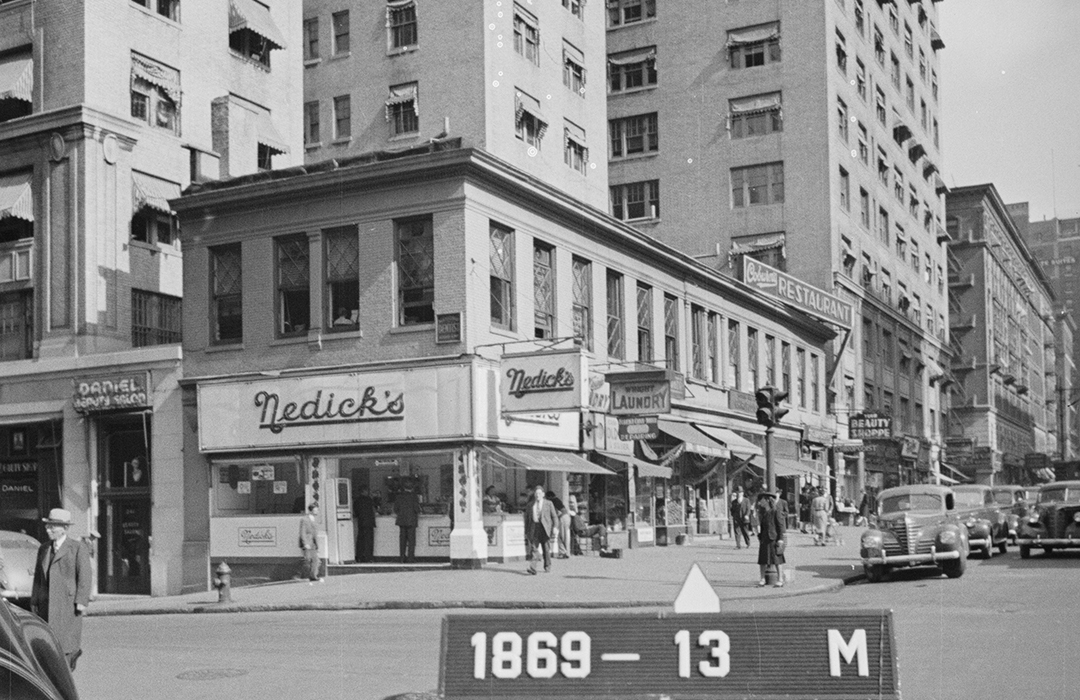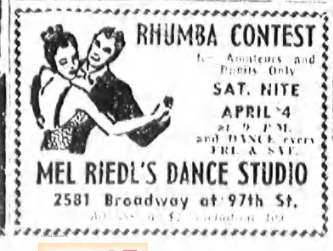
The Unter den Linden
by Tom Miller
German immigrant Gustav Stillgebauer started out in New York City as a baker. But by the third quarter of the 19th century, he had established a bier garten at 496 Columbus Avenue. Its success prompted him and his wife, Elizabeth, to purchase the “97th Street NW corner Western Boulevard” in 1897 and begin construction on a second location.
The two story, vernacular style structure was 100-feet long on Western Boulevard (later Broadway) and 25-feet wide on West 97th Street. It held a restaurant and café called Unter den Linden–a nod to the upscale thoroughfare in Berlin–and a dining room upstairs where music and entertainment were staged. On 97th Street was the open-air bier garten where locals would gather during warm months while a band would play popular music.
Unter den Linden, or Stillgebauer’s as it was commonly known, was an immediate success. Decades later, in 1942, the Long Island Daily Press recalled, “Stillgebauer’s, because it was located on upper Broadway, or ‘The Boulevard,’ was a popular stopping-off place for cyclists, who would park their bicycles and drop into the coffee-house for a special Sunday Cyclists’ Breakfast.”
[Charles E. Butter] went to court, telling Magistrate Barlow that the “sleep killing melodies which issued from Stillgebauer’s Unter Den Linden, and adjoining concert garden, were more than he could bear.”
By 1904 Gustav Stillgebauer’s son, Adolphus, had taken over the Broadway location while his father focused on Columbus Avenue. On November 19, 1904, the Real Estate Record & Guide reported that Adolphus had hired the architectural firm of Widmann, Walsh & Boissellier to double the size of the building—creating a carbon copy extension to the north. “It is said that the completed building will exceed any similar building in the city,” said the article.
Stillgebauer touted his “Famous Hungarian Gypsy Band” in his advertisements. But not everyone was especially pleased with its nocturnal offerings. On July 6, 1905, The Morning Telegraph reported, “All of the inmates of the Knickerbocker apartments, Ninety-seventh street and Broadway, are said to be afflicted with insomnia.” Most vocal in his annoyance was Charles E. Butter, the manager of the Brentano’s bookstore on Union Square. He went to court, telling Magistrate Barlow that the “sleep killing melodies which issued from Stillgebauer’s Unter Den Linden, and adjoining concert garden, were more than he could bear.”
Butter complained that he arrived home at night, tired from a hard day’s work, only to have an orchestra blaring from the open-air garden from 6:00 to midnight. He petitioned to have the music stopped at 11:00. The Morning Telegraph jokingly reported, “Close the window as tightly as you may, an alleged melody will crawl out from ‘Under the Anheuser-Busch’ to vex you; ‘Hiawatha’ is an unfriendly Indian and ‘Bedelia’ is a shameless creature who keeps outrageous hours.” Unfortunately for Butter, the judge told him, “The only thing I can advise is that you complain to the Health Board. I have no power to help you.” The sleep-deprived Butter had already tried that.
In 1920 the Stillgebauer heirs sold the building to Purchase Homes Co. Inc., which renovated the structure. There were now stores on the ground floor and a “ladies’ tailoring factory” on the second. The shops became home to branch offices of investment firms. Brokers and investment dealers C. I. Hudson & Co. opened a branch here in 1921. It was still here in 1925 when the name was changed to Dyer, Hudson & Co., and in January 1932 the brokerage firm of Chisholm & Chapman opened an office in the building.
“Close the window as tightly as you may, an alleged melody will crawl out from ‘Under the Anheuser-Busch’ to vex you; ‘Hiawatha’ is an unfriendly Indian and ‘Bedelia’ is a shameless creature who keeps outrageous hours.”
In 1953 the second floor was remodeled to accommodate a Mel Ridel’s Dancing Studio, an office, and storage. The dance school remained until 1960 when, once again, a tailoring factory moved in along with space for a synagogue.
The changing demographics of the Upper West Side neighborhood were reflected in the commercial tenants. In 1970, Perello, Inc. operated from 2585 Broadway, selling Spanish condiments like chilies, fresh coriander, and sour oranges.
The second floor became home to Cattails in 1983, described by Richard F. Shepard of The New York Times as “a cabaret, with a modest restaurant menu.” The nightly music, he said, made it, “something of a local attraction among diversion-questing West Siders.”
A long-term tenant beginning in 1985 was J’s, an American restaurant featuring live jazz. The club would remain in the space well into the 1990’s. Gustav Stillgebauer’s building, an unlikely survivor, appears a bit out of place today, surrounded by looming apartment buildings. Although a bit abused, it still recalls a much different era on Broadway, when locals gathered under leafy trees to drink beer to an oom-pah band.
Tom Miller is a social historian and blogger at daytoninmanhattan.blogspot.com
BUILDING DATABASE
Keep Exploring
Be a part of history!
Think Local First to support the businesses at 2581-2587 Broadway:
Meet Dean Vogel!



